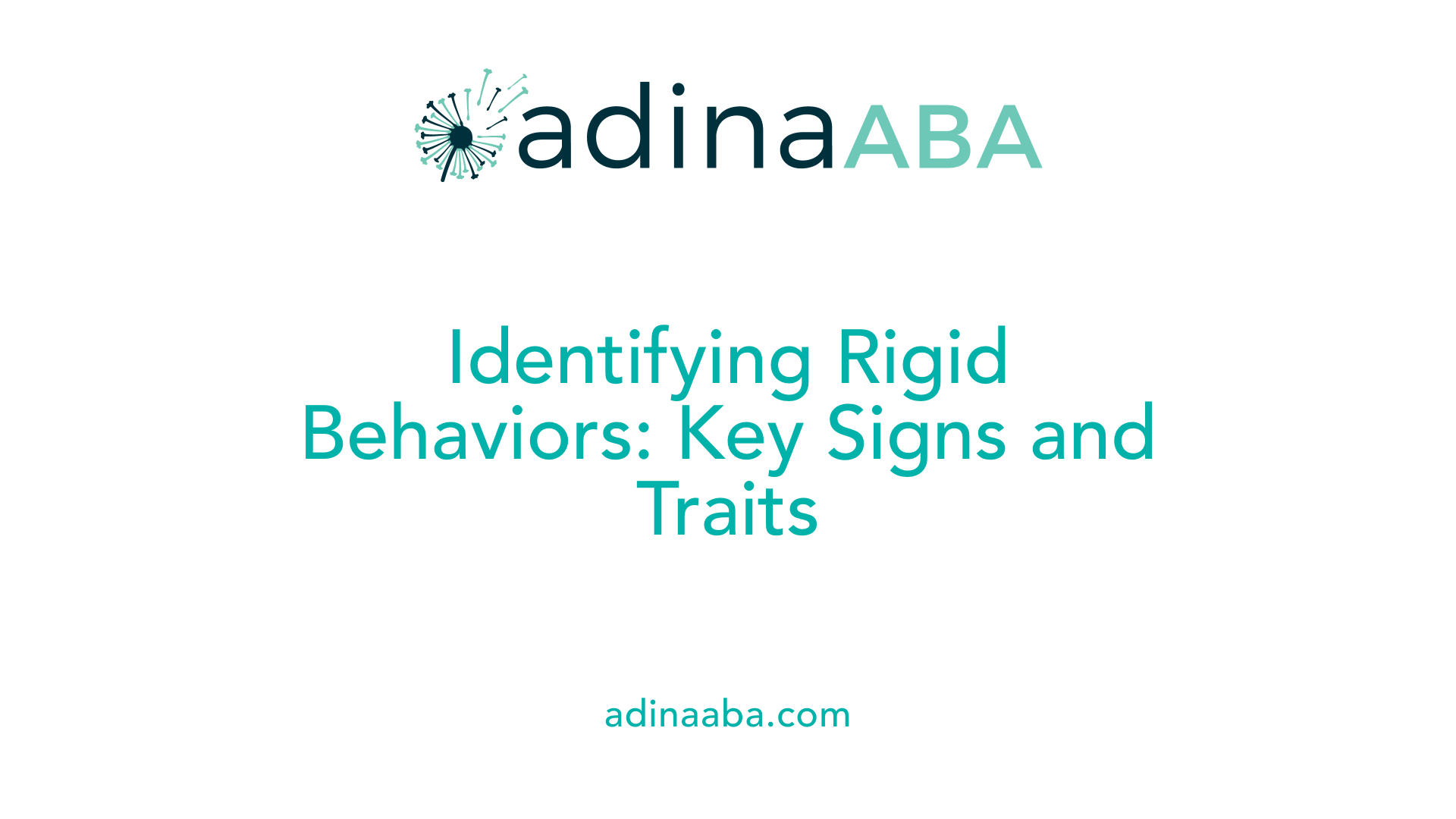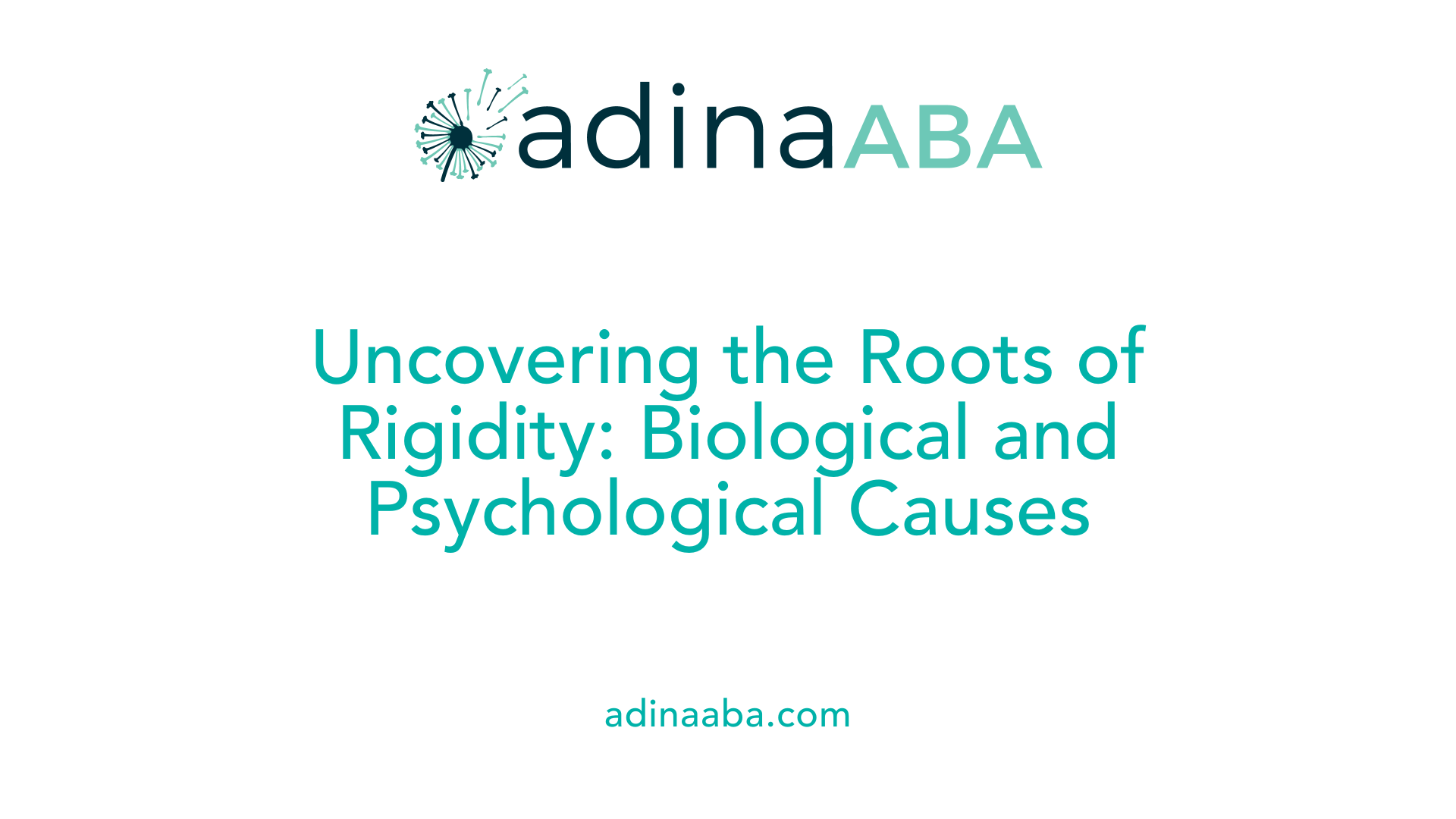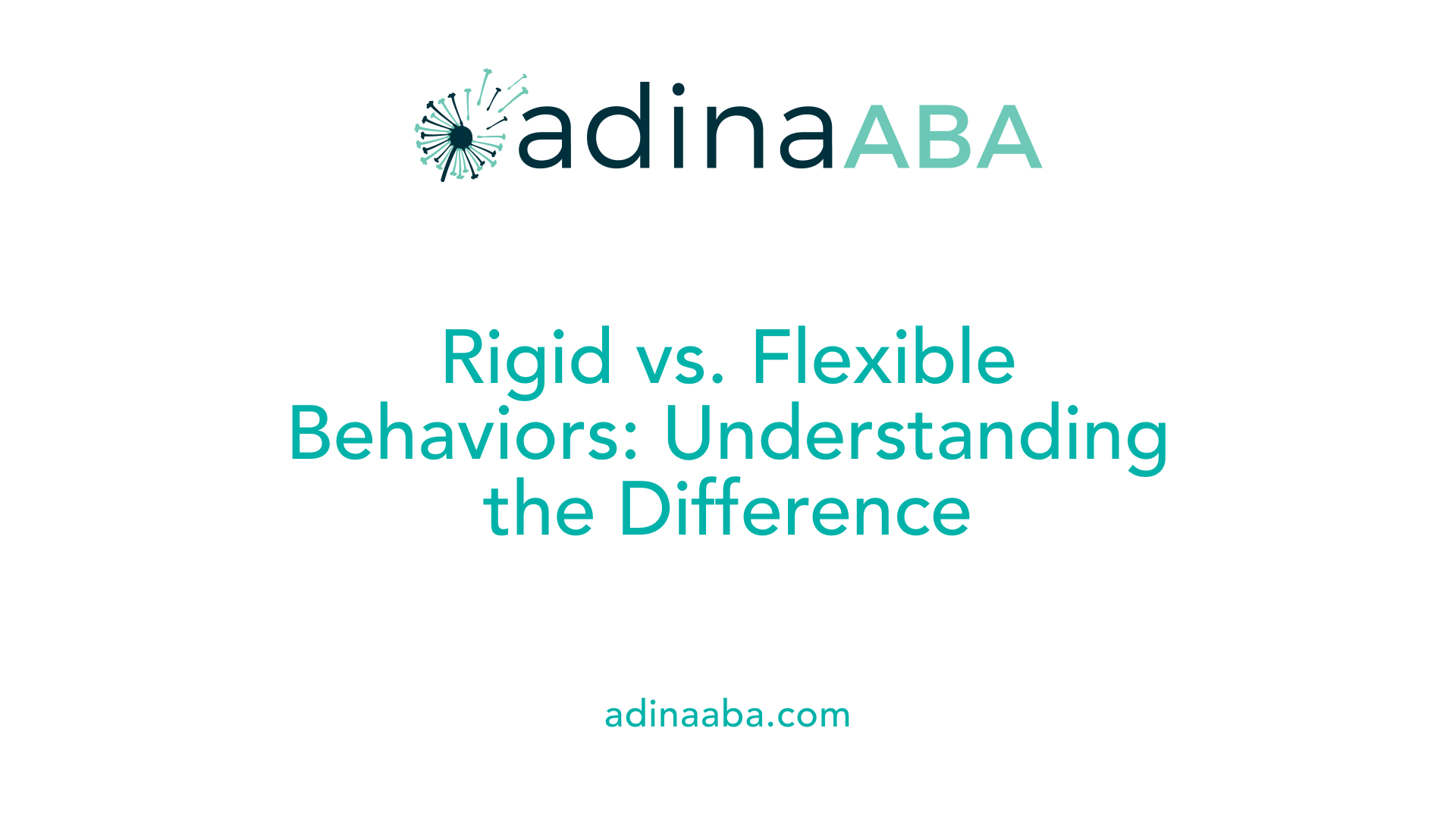How to identify overly rigid behaviors

Introduction to Rigid Behaviors
Rigid behaviors are a common feature across many psychological and developmental conditions, notably Autism Spectrum Disorder, OCD, and anxiety disorders. Recognizing these behaviors early can significantly impact intervention strategies and improve outcomes. This article explores the signs, causes, differentiation, and approaches to addressing rigidity in various populations, including children and adults.
Signs and Characteristics of Rigid Behaviors

What are the signs and characteristics of rigid behaviors?
Rigid behaviors are marked by a strict inflexibility and a strong preference for routine and sameness. People displaying such behaviors often stick to specific routines or rules, resisting any deviations or change. These individuals may show controlling tendencies, wanting order and predictability in their environment.
A common sign is resistance to change or new ideas, which can lead to difficulty adapting in social settings or unexpected situations. They might struggle with transitions, becoming upset or distressed when routines are disrupted.
Black-and-white thinking is another hallmark of rigidity. This means viewing situations in absolutes, such as all-or-nothing perspectives, which hampers problem-solving and limits perspective-taking.
Rigid behaviors can also manifest as social challenges, including difficulties in understanding others’ viewpoints, intolerance of differing opinions, or even scorn and rejection of those with different values.
These behaviors are often associated with internal traits like perfectionism, obsessive tendencies, and perseveration—repetitive focus on specific thoughts or actions. Externalizing traits might include controlling behaviors and stubbornness.
The impact of these tendencies is notable. Rigidity can hinder everyday functioning, strain relationships, and affect emotional health, especially when behaviors are deeply ingrained or severe. Recognizing these signs early can facilitate better support and intervention to promote greater flexibility and resilience.
Recognizing Overly Rigid Behaviors in Different Populations
 Rigid behaviors are recognizable through a range of observable patterns that span across children and adults. These behaviors often involve a strong insistence on sameness, resistance to change, and inflexible routines. Individuals exhibiting rigidity may show controlling or stubborn behaviors, making it difficult for them to adapt to new ideas or situations.
Rigid behaviors are recognizable through a range of observable patterns that span across children and adults. These behaviors often involve a strong insistence on sameness, resistance to change, and inflexible routines. Individuals exhibiting rigidity may show controlling or stubborn behaviors, making it difficult for them to adapt to new ideas or situations.
In children, signs of rigidity include difficulty with transitions, challenges in social interactions, and inflexibility towards new methods or ideas. They may become upset or distressed when routines are disrupted and often prefer familiar activities over novel experiences. Such children might display repetitive movements or literal interpretation of instructions, making social and environmental adaptability a challenge.
For adults, rigidity might manifest as a fixed, black-and-white outlook on life, strict adherence to routines, or an inability to consider alternative viewpoints. These individuals often prefer structured environments and may struggle with unexpected changes, leading to frustration or anxiety.
Behaviors linked to neurodevelopmental and psychological conditions such as autism spectrum disorder (ASD), anxiety disorders, and obsessive-compulsive disorder (OCD) are frequently associated with rigidity. For example, individuals with ASD often show inflexible thinking patterns, difficulty generalizing skills outside structured settings, and sensory sensitivities that contribute to rigid responses.
Underlying emotional and sensory factors also influence rigidity. Many people with rigid behaviors experience heightened sensory sensitivities or emotional dysregulation, which reinforce their need for routine and predictability.
Biologically, signs of rigidity can sometimes be identified through neurological indicators. Emerging research suggests that immune system dysregulation, such as elevated cytokine levels, may correlate with the severity of rigid behaviors. Such biological markers suggest that rigidity is not purely psychological but may also have a biological component, making it observable through neurological assessments.
Overall, recognizing rigid behaviors involves attentive observation of routines, reactions to change, social interactions, and emotional responses. Appreciating these signs helps in providing timely support and appropriate interventions for individuals struggling with rigidity.
Understanding Causes and Root Factors of Rigidity

What causes rigid behaviors?
Rigid behaviors stem from a blend of neurological and psychological origins. Neurologically, they are linked to specific brain circuitry issues such as increased supraspinal drive, disrupted reciprocal inhibition, and abnormal co-activation of muscles. These factors can cause muscular rigidity, manifesting as resistance during movement regardless of posture or speed. Additionally, decreased dopamine levels—particularly in conditions like Parkinson’s disease—play a significant role in this physical form of rigidity.
Psychologically, rigidity is often rooted in cognitive inflexibility, where individuals find it difficult to adapt their thinking to new situations or perspectives. This inflexibility is commonly observed in autism spectrum disorder but can also be a result of learned patterns from earlier life experiences. Children who have endured trauma, neglect, or abuse often develop rigid behaviors as a protective mechanism.
Theories explaining these behaviors include various models. Neurodynamic models focus on brain activity and neural pathways, while psychodynamic models see rigidity as a defense mechanism developed in response to internal conflicts or past trauma. Learning models attribute rigid behaviors to faulty or inflexible learning processes.
Environmental and stress factors also influence rigidity. Extended exposure to stress can enhance rigid tendencies, especially when individuals lack effective coping strategies. Biological components such as immune dysregulation and genetic predispositions further contribute to the complexity, making rigidity a multifaceted issue that requires a comprehensive understanding.
In summary, rigid behaviors are caused by an interplay of neural circuitry issues, neurotransmitter imbalances, learned habits, past childhood trauma, genetic factors, and environmental influences. Addressing these root causes involves a multidisciplinary approach, including neurological, psychological, and environmental interventions.
Differentiating Rigid and Flexible Behaviors

How do rigid behaviors differ from flexible behaviors?
Rigid behaviors are marked by a strict adherence to routines, inflexibility, and resistance to change. Individuals exhibiting rigidity often insist on sameness, perform repetitive actions, and struggle to adapt when circumstances shift. This type of behavior is common in autism spectrum disorder (ASD), where children and adults may insist on routine for comfort and predictability.
On the other hand, flexible behaviors showcase adaptability and spontaneity. People with flexible tendencies can shift strategies, routines, or perspectives based on the situation's needs. They are open to trying new approaches and can manage transitions smoothly.
Research shows that positive emotions linked to different mental representations influence this behavior. When positivity is tied to the methods or ways of doing things (means representations), it can reinforce rigidity. Conversely, positive feelings associated with goals or outcomes promote flexibility.
In therapeutic settings like Applied Behavioral Analysis (ABA), promoting adaptability involves integrating change into routines, offering choices, and using natural reinforcers that encourage individuals to adapt to new or unpredictable situations.
Overall, the primary difference hinges on the capacity to adjust thoughts and actions according to environmental demands or goals. Individuals with more flexible behavior can handle change resiliently, while those with rigidity tend to resist alterations, which can impact learning, social interactions, and emotional well-being.
Common Examples of Rigid Behaviors and Their Manifestations
What are some common examples of rigid behaviors?
Rigid behaviors can manifest in several visible ways, especially in children and individuals with certain neurodevelopmental or psychological conditions. One of the most noticeable signs is insisting on strict routines and schedules. These individuals often prefer to follow the same daily activities or rituals daily, resisting any deviations or surprises. For example, a child might insist on performing the same sequence of activities every morning, such as dressing in a specific order or eating a particular breakfast.
Resistance to change is another hallmark. They may have difficulty adjusting to new environments, changing plans, or adapting to unexpected circumstances. This inflexibility can cause distress when routines are disrupted or when they face unfamiliar situations.
In their approach to problem-solving, rigid individuals tend to stick to a single method or strategy. They may struggle to adapt when their usual approach doesn’t work and might reject alternative solutions. For instance, a child might only solve problems by using the same tried-and-true method, even if it isn’t effective, and dismiss or ignore other tactics.
Repetitive behaviors are common, both in actions and speech. These behaviors include stereotyped movements like hand-flapping, rocking, or repeating certain phrases. Such actions serve as comfort mechanisms but also exemplify rigidity. Stubbornness and controlling tendencies often follow, where they seek to dominate situations or resist others' ideas or rules.
Social rigidity can also appear as controlling behaviors, insistent opinions, or a reluctance to accept differing viewpoints. They might refuse to accept others’ suggestions or feedback, often dismissing perspectives that don’t align with their own.
Furthermore, individuals displaying rigidity may fixate on specific interests or topics, exploring them obsessively or focusing excessively on details. This can limit their engagement in wider social or learning activities.
These behaviors are frequently observed in conditions such as Autism Spectrum Disorder (ASD), Obsessive-Compulsive Disorder (OCD), Attention Deficit Hyperactivity Disorder (ADHD), and various anxiety disorders. Recognizing these patterns helps caregivers, teachers, and clinicians develop strategies to support flexibility and emotional regulation, ultimately promoting better social and adaptive functioning.
Implications on Personal Development and Relationships
 Rigidity can have profound effects on both personal growth and the quality of relationships. When individuals exhibit inflexible behaviors and thinking patterns, it becomes challenging to communicate effectively, understand others, or find common ground. This often leads to conflicts and misunderstandings, as rigid individuals tend to see their own perspectives as the only valid ones, dismissing differing opinions with scorn or rejection.
Rigidity can have profound effects on both personal growth and the quality of relationships. When individuals exhibit inflexible behaviors and thinking patterns, it becomes challenging to communicate effectively, understand others, or find common ground. This often leads to conflicts and misunderstandings, as rigid individuals tend to see their own perspectives as the only valid ones, dismissing differing opinions with scorn or rejection.
Socially, a person resistant to different views may become isolated. They might avoid engaging with diverse groups or conversations that challenge their beliefs, increasing social distance and reducing opportunities for learning and personal expansion.
In terms of personal development, inflexibility limits adaptability. Such individuals struggle to handle change or stressful situations, resulting in heightened anxiety, stagnation, and emotional exhaustion. Their inability to consider alternatives or new approaches prevents important growth opportunities. This rigidity can also lead to the build-up of resentment over unresolved issues, as they tend to cling to routines or beliefs, resisting necessary adjustments.
Within relationships, rigid behaviors diminish the capacity for empathy and compromise. Partners or friends may feel undervalued or misunderstood, which can cause conflicts to escalate or relationships to fail altogether. Especially in long-term partnerships, inflexibility obstructs constructive problem-solving, often leading to emotional distancing or disconnection.
While in some contexts rigidity might offer a sense of control and stability, excessive inflexibility typically undermines both personal well-being and relational harmony. It alters how individuals cope with life's unpredictability and how they relate to others, making flexibility and openness vital for enduring emotional resilience and meaningful connections.
| Aspect | Impact | Additional Notes |
|---|---|---|
| Relationship challenges | Conflicts, misunderstanding, social distancing | Rigid individuals often dismiss others' viewpoints, leading to disputes |
| Social isolation | Avoidance of differing views, reluctance to engage | Limits social connections and learning opportunities |
| Personal growth | Reduced adaptability, stress, stagnation | Hinders emotional resilience and lifelong learning |
| Emotional inflexibility | Difficulty processing change, emotional outbursts | Can cause frustration and unresolved conflicts |
| Long-term effects | Stagnation, resentment, relationship breakdown | Persistent rigid behavior often leads to social and emotional difficulties |
Understanding the implications of rigidity underscores the importance of developing flexibility—both in thought and behavior—to foster healthier relationships and personal well-being. Embracing change and diverse perspectives not only enhances individual growth but also fosters stronger, more meaningful connections with others.
Psychological and Therapeutic Perspectives on Rigidity
Are there psychological explanations or traits associated with rigidity?
Rigidity in psychological terms often manifests through specific traits that influence how individuals think, feel, and behave. People exhibiting rigid behaviors tend to show high levels of perfectionism, inflexibility in thinking, and a strong aversion to novelty or change. These traits are frequently linked to mental health conditions such as depression, anxiety, trauma, and even obsessive-compulsive disorder.
This pattern of behavior can be understood as an automatic response to stressful or overwhelming situations. When feeling unsettled or threatened, individuals may default to rigid routines or fixed beliefs to regain a sense of control and safety. This defensive mechanism often involves limiting the amount of information processed or resisting any change, which can hinder emotional perception and foster hostile or intolerant attitudes.
Underlying these traits are neural mechanisms within the brain that reinforce fixed thought circuits. Overactivity in certain areas, such as the anterior cingulate gyrus, has been observed in rigid thinkers, impairing their ability to shift thoughts and adapt to new circumstances. Fixed beliefs and cognitive patterns serve as the brain’s way of creating predictability but often at the expense of flexibility.
Therapeutic approaches aim to weaken these maladaptive patterns and promote adaptive, flexible thinking. Mindfulness-based techniques help individuals become aware of their thought patterns without judgment, enabling them to reorganize neural connections and break free from rigid habits. Cognitive techniques such as cognitive reframing challenge all-or-nothing beliefs and encourage viewing situations from multiple perspectives.
Ultimately, rigidity is both a stable trait and a dynamic process influenced by neural pathways, stress levels, and psychological entropy. It can be mitigated by fostering acceptance, increasing awareness, and encouraging openness to uncertainty, which helps individuals navigate life's complexities more adaptively.
Concluding Insights and Recommendations
Recognizing overly rigid behaviors requires careful observation of patterns such as resistance to change, inflexibility, and control tendencies. These behaviors often serve as mechanisms to manage fear, anxiety, or uncertainty, especially in individuals with autism, OCD, or anxiety disorders. Differentiating rigidity from adaptability involves noting how individuals respond to change and whether they display black-and-white thinking or literalism. Addressing rigidity involves a combination of compassionate understanding, behavioral interventions, cognitive re-framing, and promoting flexibility through gradual exposure and positive reinforcement. Developing awareness of underlying causes, including neurological, psychological, and environmental factors, enhances the effectiveness of tailored strategies. Ultimately, fostering behavioral flexibility not only improves personal resilience but also enhances relationship quality and emotional well-being.
References
- Rigid Behavior in Childhood - Marcy Willard PhD
- Fixed Forms of Behavior as Excessively Rigid Behavior in Normal ...
- Controlling, Rigid, Argumentative Behavior (What It Means and What ...
- Rigidity & Inflexibility In Kids With Autism - Circle Care Services
- 10 Ways to Reduce Rigidness, Decrease Anxiety, Increase ...
- Are You Too Routinized and Rigid? Maybe You're Anxious
- Options for responding well to an overly-rigid person - Peter K. Gerlach
More Resources
Expert Clinicians
Get started today ->



.jpg)


.jpg)